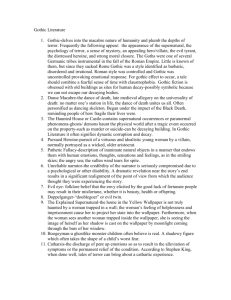

Gothic fiction is distinguished from other forms of scary or supernatural stories, such as fairy tales, by the specific theme of the present being haunted by the past. Gothic fiction is characterized by an environment of fear, the threat of supernatural events, and the intrusion of the past upon the present. The ruins of Wolf's Crag castle in Walter Scott's The Bride of Lammermoor (1819) Twentieth-century contributors include Daphne du Maurier, Stephen King, Shirley Jackson, Anne Rice and Toni Morrison. Later prominent works were Dracula by Bram Stoker, Richard Marsh's The Beetle and Robert Louis Stevenson's Strange Case of Dr Jekyll and Mr Hyde. The early Victorian period continued the use of gothic, in novels by Charles Dickens and the Brontë sisters, as well as works by the American writers Edgar Allan Poe and Nathaniel Hawthorne. Hoffmann frequently drew upon gothic motifs in their works. The Gothic influence continued into the early 19th century, works by the Romantic poets, and novelists such as Mary Shelley, Charles Maturin, Walter Scott and E. Subsequent 18th century contributors included Clara Reeve, Ann Radcliffe, William Thomas Beckford, and Matthew Lewis. The first work to call itself Gothic was Horace Walpole's 1764 novel The Castle of Otranto, later subtitled "A Gothic Story". The name is a reference to Gothic architecture of the European Middle Ages, which was characteristic of the settings of early Gothic novels. Gothic fiction, sometimes called Gothic horror in the 20th century, is a loose literary aesthetic of fear and haunting. The aesthetics of the book have shaped modern-day gothic books, films, art, music and the goth subculture. The Castle of Otranto (1764) is regarded as the first Gothic novel.


 0 kommentar(er)
0 kommentar(er)
